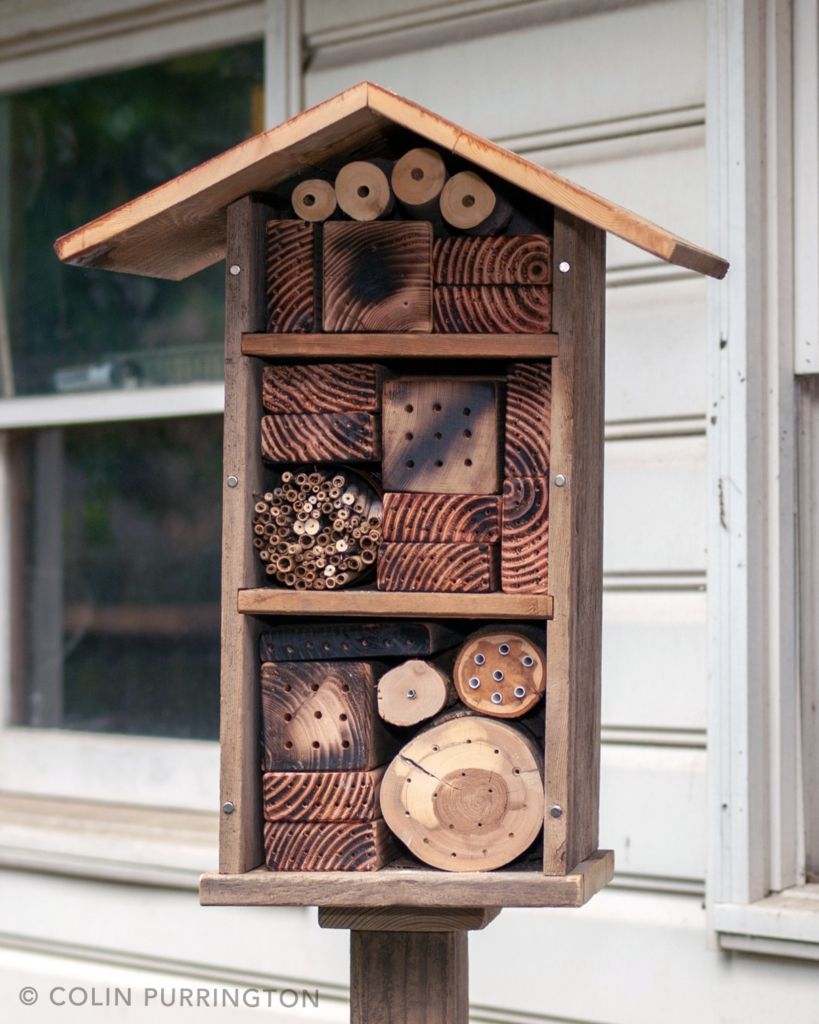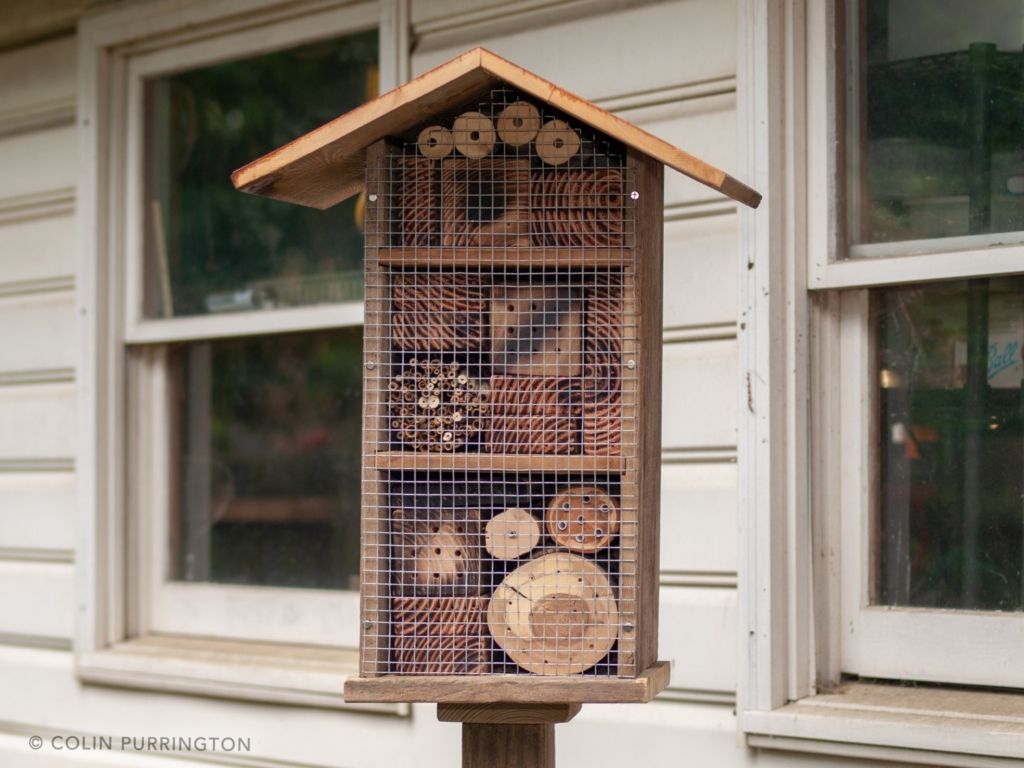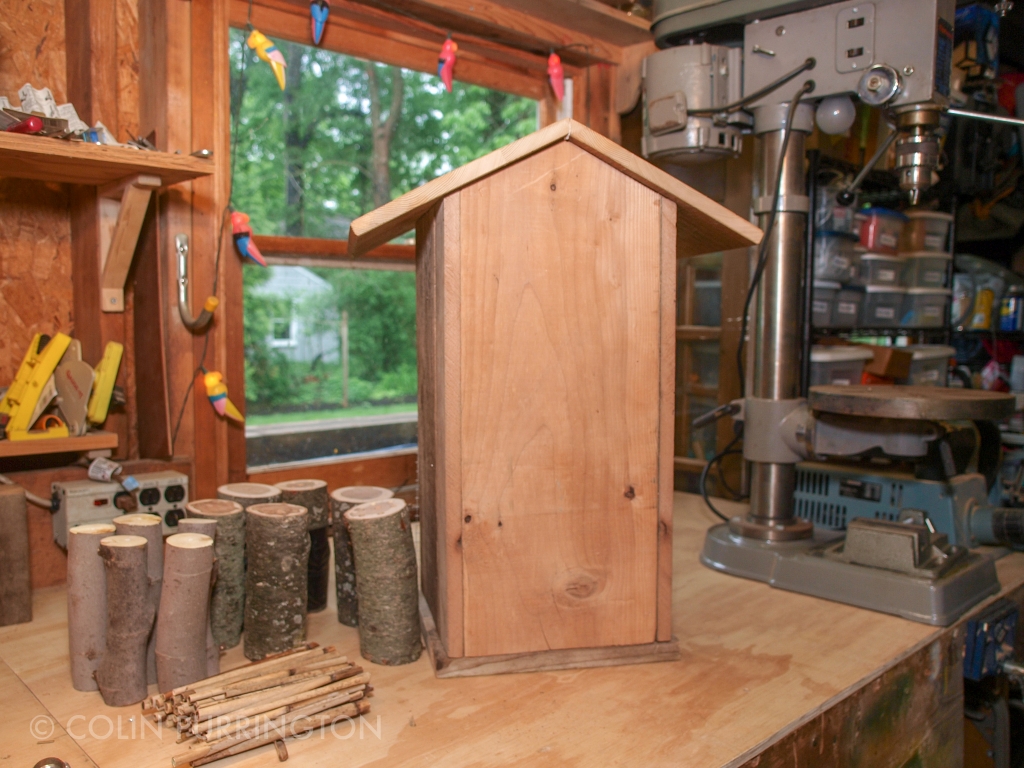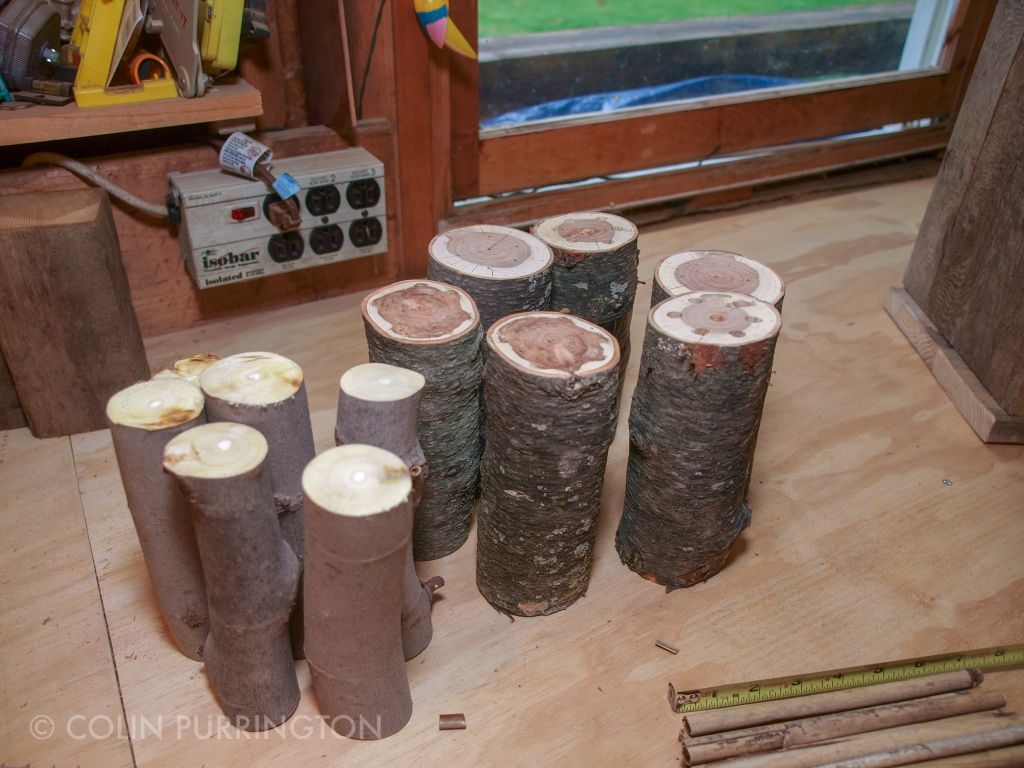I built a hotel for mason bees, leafcutting bees, and hole-nesting parasitic wasps and thought I’d post pics in case anybody is looking for tips on how to make one. Overall dimensions are 12″ (W) x 25″ (H) x 11″ (D) and situated facing southeast so that it catches some good morning sun (the bees like that). I gave it three levels so that I can fuss with one level without disrupting all the tenants (bees hate that), plus used dado joints give the whole structure some stability when fully loaded. The hotel is elevated to 4 feet on a 4 x 4″ post so that I can easily take photographs without stooping.

I also have a piece of galvanized hardware cloth that can be attached (pic below), after all the holes are filled, to keep woodpeckers away. The wire is held by six neodymium magnets glued into small insets on each side. I’ll probably redo it with larger-hole chicken wire, and make it project farther away from the surface. The back of the hotel is a slab of 2×10. To attach the hotel to a post I used a small piece of wood that is first attached to the post, then attached to bottom of the house via four screws (shown below). Everything is just scrap wood from some dismantled cedar planters. Below are some pics:
Hole diameters
There are hundreds of different bee (Megachilidae) and wasp species that nest in holes, and all have slightly different preferences for wood type, hole diameter, and depth, so I’ve offered them a variety of accommodations in reeds, logs, and milled lumber, all cut into 7-inch lengths. The reeds are from Phragmites, and each section is cut so that the end has a node, leaving approximately 6 1/2 inches of usable tube. Logs and blocks are drilled with variable sizes of bits. The large log on bottom right also has a mix of 7/16-in and 1/8-in holes, some of which are already filled up (with mixture of nectar, mud, pebbles). Directly above the large log are two smaller ones that show how you can insert 6-in paper tubes into holes. At the end of the season you can easy pull those tubes out and transfer them to a protected location or refrigerator to overwinter. The other advantage of these disposable paper tubes is that you can easily unwind them to collect, study, and clean the pupae. The other paper tube is just a drinking straw I found on Amazon. These tubes will probably not be used this summer but I have them there just in case (the tubes are used by Spring mason bees and my house went up a bit too late this spring to attract any, I think). Finally, I have a few large-bore holes up in the attic space just in case that might appeal to a larger bee or wasp, though I probably won’t get a taker.
At the end of the season I’m going to gather up all the wood and reeds and place them in a protected location until next year. I’ll probably end up building a hatching box. After emergence ends I’ll either clean out the wood for reuse or throw it out. You need to do one or the other or risk causing diseases, mites, and parasitoids to build up in your bee house. To give you a visual on one risk, here’s a photo of a mason bee loaded up with phoretic mites. See also the Maclvor and Packer 2015 article, below.
Design tips
- For larger hole sizes you want, ideally, 6 inches of depth. Shorter (4″) tunnels would be OK but can result in a male-biased brood sex ratios. If you want to encourage population growth, encouraging females is important.
- To keep everything dry on something this tall you need a generous roof overhang. Mine extends 5 inches beyond the front of the shelf, plus the wood sections and reeds are set back from that by another inch or so. If you have a shorter house you can have a smaller roof.
- Burning the front of the wood allows bees to more easily find their holes, plus the darker surface causes the wood to heat up faster in the morning sun.
- Don’t use treated lumber or fresh cedar. Kills the larvae, apparently, or at least that’s the recommendation on the internet.
- Pine is fine but I think harder wood is preferable because the drilled holes are smoother.
My goals for building this house are mainly for edutainment (please join my iNaturalist project if you’re interested) but a bonus would be better pollination of my kiwi vine and strawberries. But that’s not a guaranteed because many solitary bees are oligolectic (collect pollen from only certain species of plants), and I’m not sure which species specialize on Actinidia and Frageria. I’m looking forward to next year when I can put out the blocks for (larger) spring mason bees, which I think are good for early strawberry pollination.
UPDATE: New blocks for 2019
Here’s a photograph of the fresh nesting accommodations I installed in the above hotel. Blocks have a variety of hole diameters to accommodate a variety of bee and wasp species: 3/16″, 5/16″, 5/8″, and 12mm. Hipster add-on apartment is for smaller Hymenopterans and is made from a Saint Benjamin Brewing Little White Lies IPA (design by Kathryn Moran) can packed with 5 1/2″ sections of swamp milkweed and wild begamot.
Further reading
- Bauer, E.C., L.I. Lynch, D.A. Golick, and T.J. Weissling. 2015. Creating a solitary bee hotel.
- Carlton, M. 2017. How to make and manage a bee hotel: instructions that really work.
- Edmunds, B., R. Little, and R. Sagili. 2016. Nurturing mason bees in your backyard in Western Oregon.
- Fabre, J.H. The Mason-Bees.
- Farmer, C. Leafcutter bee nests.
- Green, A. Checking into bee hotels.
- Hunter, D., and J. Lightner. 2016. Mason Bee Revolution: How the Hardest Working Bee Can Save the World – One Backyard at a Time.
- Krombein, K.V. 1967. Trap-nesting Wasps and Bees: Life Histories, Nests, and Associates.
- Maclvor, J.S. 2017. Cavity-nest boxes for solitary bees: a century of design and research. Apidologie 48:311-327.
- Maclvor, J.S., and L. Packer. 2015. ‘Bee hotels’ as tools for native pollinator conservation: a premature verdict? PLoS ONE 10:e0122126.
- Mader, E., M. Shepherd, M. Vaughan, and J. Guisse. Tunnel nests for natives bees: nest construction and management.
- McGlynn, D. 2009. Backyard boarding house: how a power drill can attract pollinators.
- Moon(?), C. How to make solitary bee houses.
- Morato, E.F., and R.P. Martins. 2006. An overview of proximate factors affecting the nesting behavior of solitary wasps and bees (Hymenoptera: Aculeata) in preexisting cavities in wood. Neotropical Entomology 35:285-298.
- Nye, W.P. and G.E. Bohart. 1964. Equipment for making nesting holes for the alfalfa leaf-cutting bee.
- O’Neill, K., and J.F. O’Neill. 2013. Cavity-nesting wasps and bees (Hymenoptera) of Central New York State: the Roy H. Park Preserve and Dorothy Mcilroy Bird Sanctuary. Proceedings of the Entomological Society of Washington 115:158-166.
- Palmer, D. 2017. Adventures of an amateur mason bee keeper.
- Phillips, E. Wasps in the bee hotel!
- Sandlin, D.T. 2017. The hidden dangers of bamboo. Crown Bees blog.
- Seidelmann, K., A. Bienasch, and F. Pröhl. 2015. The impact of nest tube dimensions on reproduction parameters in a cavity nesting solitary bee, Osmia bicornis (Hymenoptera: Megachilidae). Apidologie 47:114-122.
- Tei-Weisenburger, J-L. 2017. Insect hotels: a refuge or a fad?
- Werner, D. Schautafeln zum Thema Insektennisthilfen und Wildbienen.
- Werner, D. Fertig zum Einzug: Nisthilfen für Wildbienen.
- Wilson, J., and O. Messinger Carrill. 2015. The Bees in Your Backyard: a Guide to North America’s Bees.
- Xerces Society. 2009. Tunnel nests for native bees: nest construction and management.







